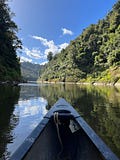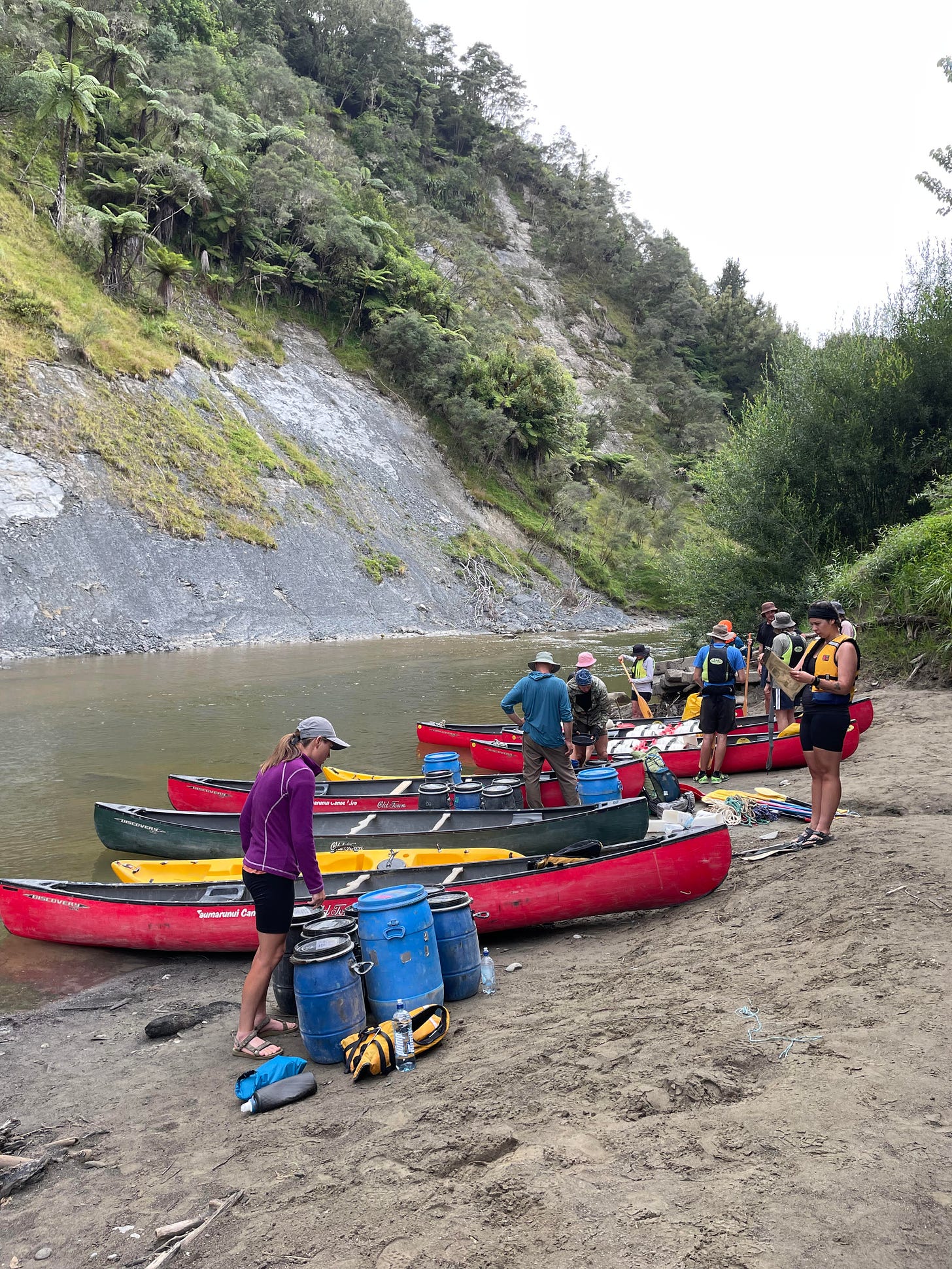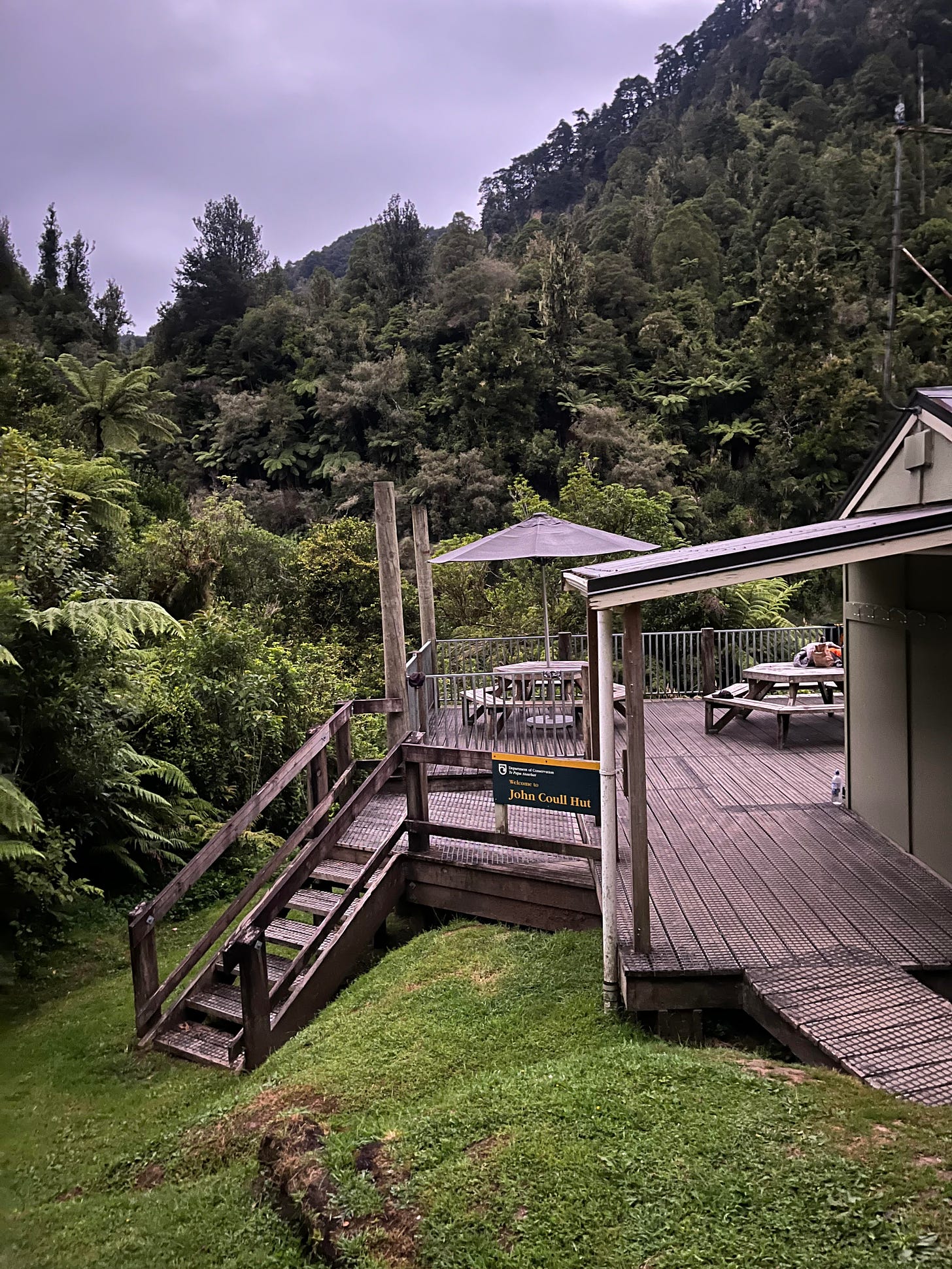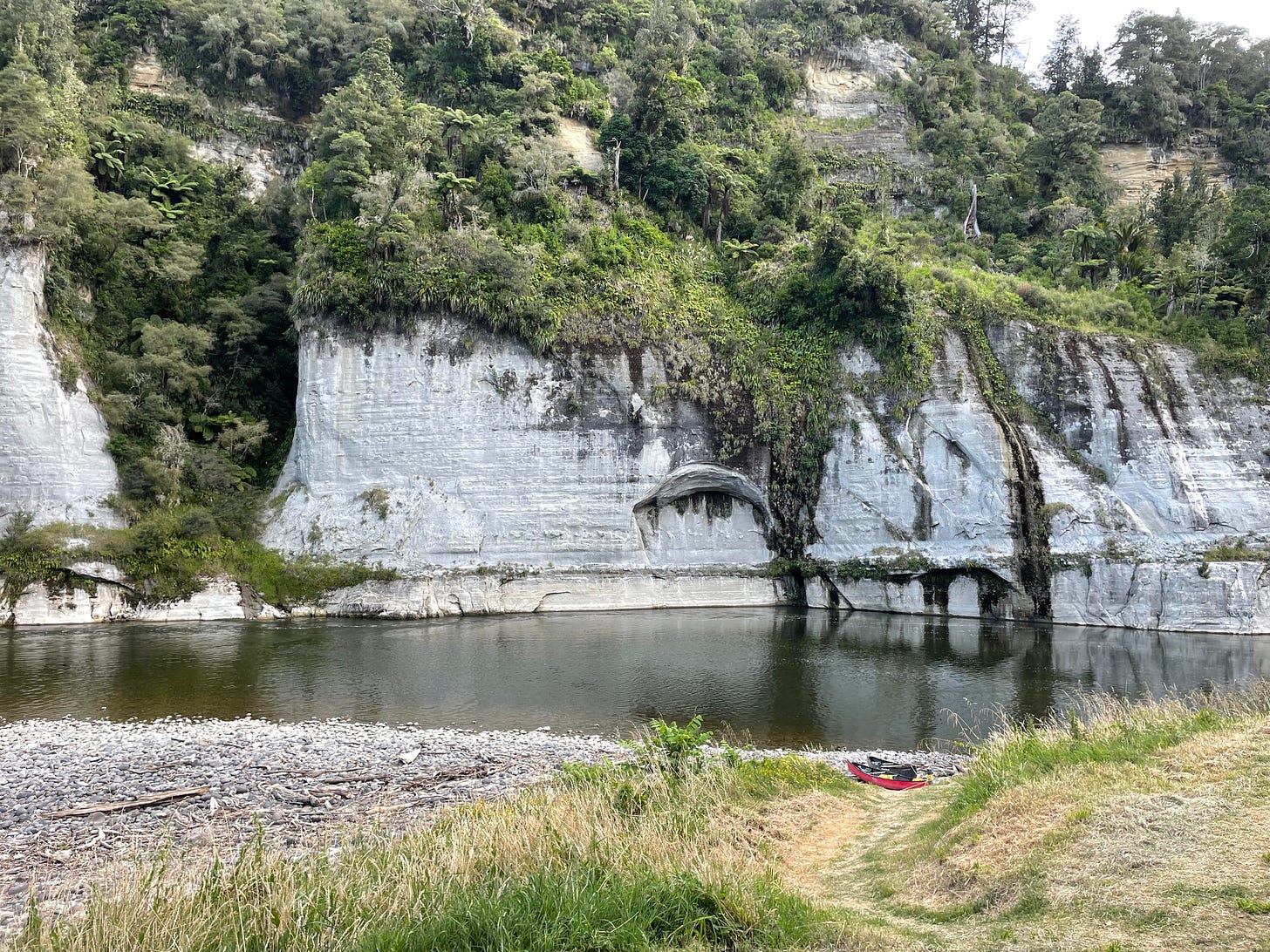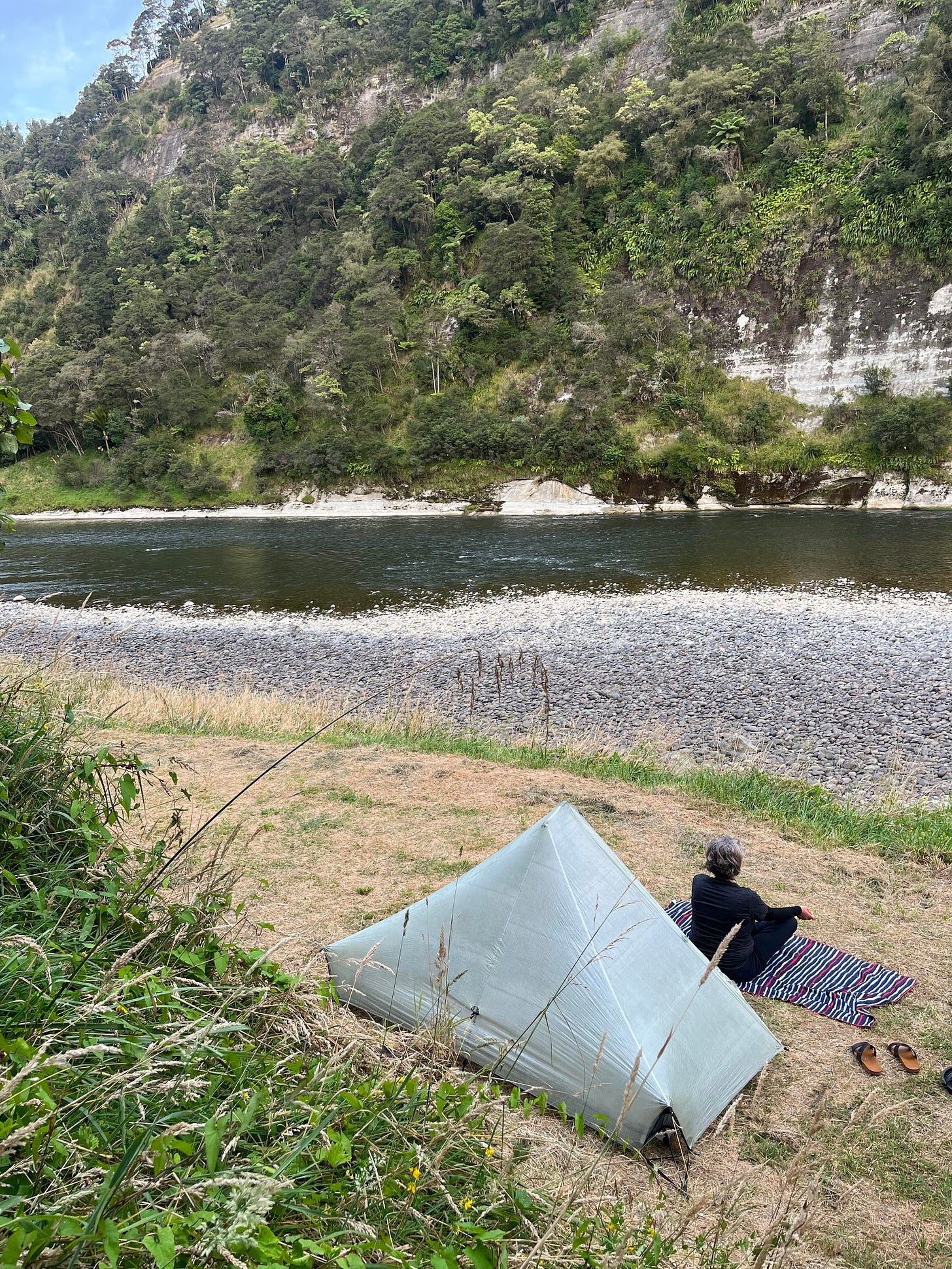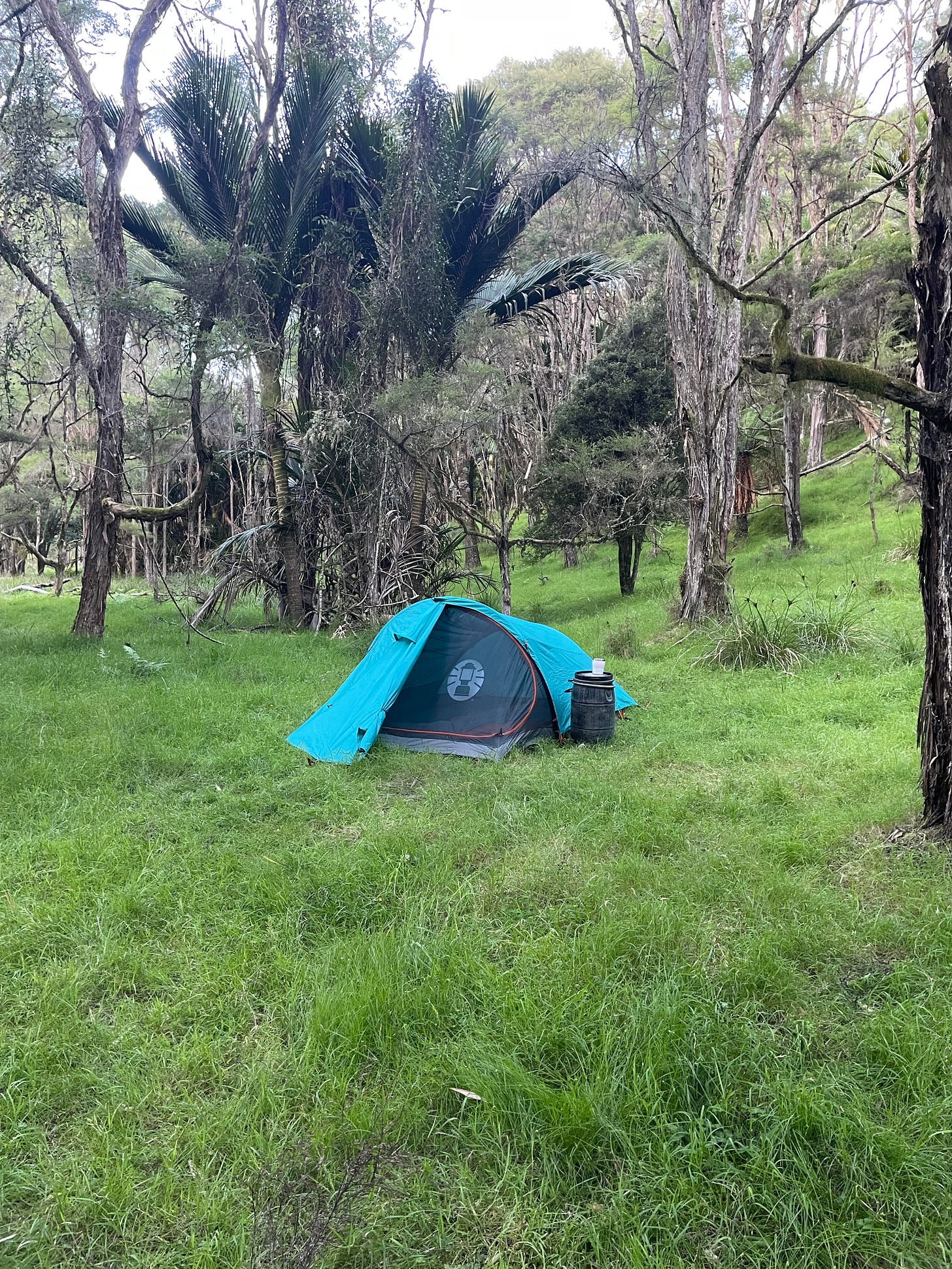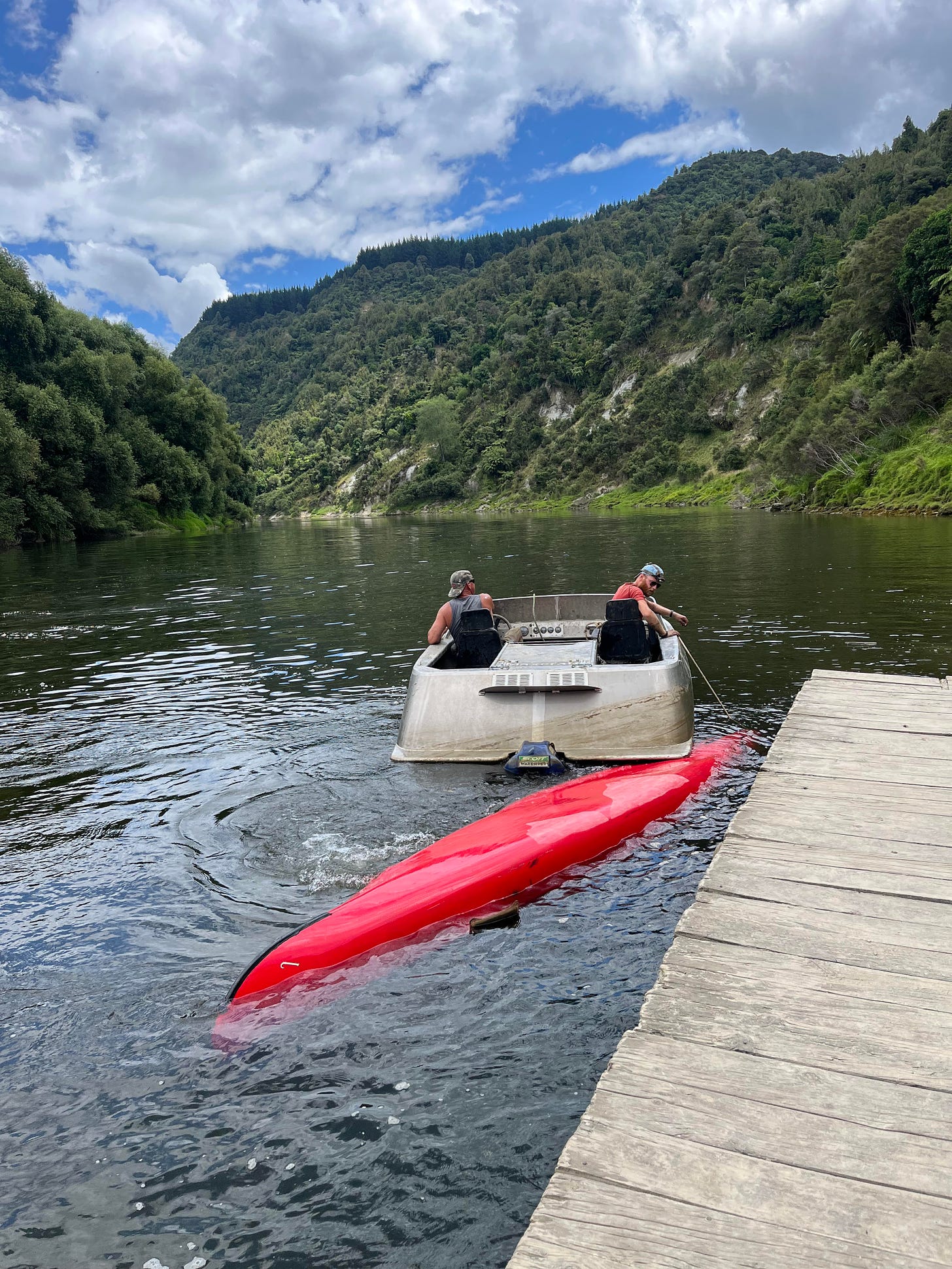How to Brew a Goat
Take a woman, put her on a river with her adult daughter for five days and watch the goat emerge.
Bucket list items sit waiting, so patient and with unwavering hope that a space will open up in our consciousness to bring them to fruition. Paddling the Whanganui River has sat on mine, the ink fading, the thought gathering dust until one day, there it was, the opportunity. My daughter was heading towards the river on her Te Araroa walking mission, and I was going to go along for the ride!
I didn’t think about it much, I just knew this was it, and I could trust synchronicity to do the rest, so I didn’t attend to much detail. I headed in the general direction in my campervan, knowing the dates would align and let my girl book what needed booking; a canoe and a few campsites. I figured I’d have everything I needed by way of clothing and camping equipment, so I stopped off for my regular writing session between 10 am and 2 pm en route before meeting her and a trail mate on the eve of our departure. They’d been waiting, napping in a park in Taumaranui - you get good at uncomfortable sleeping on a three thousand kilometre walk by all accounts. There they were, heading towards the van, slightly mountain goatish in their sure-footedness born of many a tricky track over the past six weeks carrying everything they needed for survival.
The first stop was the supermarket. Here the goat gets a bit skittery, overthinking what food would be best for the next five days on the river. The added luxury of being able to choose heavier items, as we would be carrying them in our canoe rather than on our backs, was discombobulating. Exiting the makeshift New World thirty minutes later, replete with cans, jars, and a goon of cheap cabernet merlot, ensured we maximised the joy of heavy packaging. I turned to find the girls laughing at the mother pushing the trolley up the middle of the side street to where the camper was parked. I wasn’t a goat yet.
Arriving at the canoe base camp, we found a place to park for the night, and then I was initiated into the goat unpack-repack ritual. Admittedly, it was out of packs and into waterproof barrels for river carriage, but this also happens out of and back into backpacks - an intimate knowledge of pack contents and layout is essential. What becomes apparent during this custom is how long it has been since the last shower and clothes washing. The longer it has been, the more like a goat, the pelts being extracted from the pack smell. Apparently, it is preferable to be upwind of a trail walker who has not found some washing water for a while.
An intense focus on sustenance followed much mulling and contemplation of the packing. It was a novelty having more than one pot and one implement to nutrient load from, and as a goat-in-training, I absorbed it all. I felt my worldly attachment to comfort being stripped away. I offered my daughter’s trail mate a bed in the van, freshly made with clean linen. However, in a surprisingly uncoordinated fashion for a mountain goat, she climbed up to the bed above the dining area with her sleeping bag, preferring her familiar cocoon. An anticipatory sleep followed for all of us, knowing we had to be at the safety briefing early the following day.
Sitting amongst tourists and paddling paraphernalia the next morning, I noted a shift in my soul, a new feeling or was it an old feeling? Something in my veins reminded me of travelling when I was young. The wonder of new places, the connectedness of people about to share an adventure, and the hope of new thinking. Right there and then, I started to reframe my plans for the rest of the year. Maybe my wandering was only just beginning.
The warnings about capsizing, sinking, and canoe destruction pulled our eyelids apart as we looked sideways at each other. The 50:50 rapid was called that for a reason we were told during a demonstration on how best to deal with unintentionally exiting your boat. My metabolic rate went up during this part of the demonstration, and on reflection, I wonder if it was because I needed a goat’s resting heart rate to traverse this river.
I’m not sure what I expected at the launch, but maybe a bit more fanfare. Instead, we were pushed off by canoe hire staff, who seemed somewhat bored with amateurs. Me, the heavier “rudder” at the back and my daughter, the “engine room” at the front, were for the first few kilometres just a zig-zag of epic proportions. However, during the course of the day and with numerous rapids to help with our training, we started to tune in to the subtleties of working intuitively together…until fatigue set in, that is, then it was just a moaning mess. Keen to cushion the fall, my daughter asked if it was time for wine from about 3 pm onwards and was finally rewarded with a mug full of overly warm cask red.
Our arrival at John Coull hut was coloured with my rant about stuff being named after white men, which my daughter felt was too much of a generalisation given that I knew nothing of the history. Although after reading said history on the information boards at the hut, I didn’t change my stance but did appreciate his work. While gloriously situated, the campsite was teeming uncomfortably with Wellington anniversary weekend walkers and paddlers and going to sleep with twenty-five strangers was not my favourite. Neither was weaving along the river with multiple watercrafts the following day and getting out of the way for peace-destroying jet boats the worst.
We found some solitude in the final few hours of day two by slowing down to a snail’s pace and letting the current and goon wine take us. Forty-five kilometres later, we arrived at the jewel in Te Awa Whanganui’s crown; Ngaporo campsite. Rounding the final bend, my daughter called triumphantly, “Mumma, we’re here!” And as we glided into what can only be described as Mother Nature’s cathedral, we were awestruck. Dramatic cliff faces and virgin native forests wed by the earth’s circulatory system that flowed between them.
Pulling up, we were pleased to find much fewer campsite residents than the night before, giving us some peace to take in the full wonder of our surroundings. While pitching tents and organising food on elevated steps that took us out of danger of unexpected rising water levels, we noticed a couple of goats on the opposite side of the river. It was impossible to imagine how they had got there without scaling sheer cliff faces, further deepening my awareness of the secrets of goats.
Day three was a mission, forty-eight kilometres and unbeknown to us, it included the 50:50 rapid. We travelled the day as a watercraft foursome, three canoes and a kayak carrying three kiwis, two Germans, an Aussie and a young French guy. We felt a bond after sharing a night at Ngaporo; such is Mother Nature's power. When we set off, we didn’t realise that that bond would strengthen through the shared trauma of the rapid, named 50:50 for a reason. I looked at my daughter’s face as we processed the imminent certainty of tipping out once we hit the turbulence.
We collected paddles and shoes with goat-like intention as they floated past while directing our waterlogged canoe across swift currents to a rocky outcrop. From here, we paused, checked our well-being, assessed loss and damage, and then proceeded to bail and repack our canoe while watching two of our river companions meet the same fate as us. The upright boats went between the two that weren’t, delivering found items and ensuring we were ok; the goat was strong in them.
Back on the water, we became aware of some frayed nerves and decided to stop at Pipiriki and throw some carbohydrates at the after-effects of our fight or flight response to being on the wrong side of the 50:50. Wet, cold, and a bit shaken we proceeded to enquire about upcoming rapids, oscillating in that space between accumulating expertise and being put off altogether. My daughter and I felt tension threatening our assimilation, and this played out during the tricky ‘rapid finale’ just beyond Jerusalem. Needless to say, stopping to anticipate only served to quicken our bowels and shouting at cross purposes didn’t enhance our performance; instead, it got on our goat.
There was some backwards-facing and a bit of water taken on, but we made it through the rapid upright and relatively empty. Although, the real success was in the thoughtful conclusions we reached and shared during the following hour after realising that our communication challenges could be traced back to specific points of origin.
Our paddling partners waited to ensure our successful navigation of the last big challenge, and we proceeded to Downe’s Hut without further drama. We were slightly mortified at the steep ascent of the goat tracks we would need to climb carrying our barrels of food and equipment. But there was still more in the tank, and I delighted in my endurance and agility that was sure to contribute towards a good goat graduation grade.
Sharing food with our new tribe that night turned my gaze outwards as I communed with travellers whose entire lives were dedicated to adventuring. I felt the stirring in my soul again as I realised the connection to ‘source’ that seems so much more accessible in nature and seemed to drive these humans across our planet.
Settling down that night in my tent, with which I had developed a fond attachment, pitched in a nikau grove on soft mossy grass, I proceeded to sleep more contentedly than I have in a very long time. I dreamed of staying connected like this forever and woke up thinking about my travel plans later this year and smiled as I realised it would now be with a pack on my back. I set about my morning routine with a heart full of gratitude. I was seeing the world from an altered perspective, and it felt good.
The following two days of paddling were broken by an overnight at Hipango Park, where the river is close enough to the coast to be tidal, dictating our departure time the next day. There was a weird vibe here. Apparently, “the pa burned down two hundred years ago”, but I wonder if the wording should be “the pa was burned down two hundred years ago”; it seemed more likely. I didn’t believe the information board’s account of the area's history. I felt an unease here like something was being hidden, a truth silenced.
And then there was Muz, the guy on the next hill blasting rock music through the valley and driving his quad bike like a pro along precarious ledges. His skills were to come in handy when we woke to a submerged canoe the following day after the jetty and tide conspired to strand us. Muz came at us with his quad bike, jet boat, mate, and catchphrases, “many hands make light work…work smarter, not harder…your head isn’t there just to keep your ears apart”, and low and behold, an emptied canoe sitting atop the river once again. We declined the invite to ‘beer o’clock’, preferring to set off with the turn of the tide for our final leg into Whanganui.
It was a bit anticlimactic to paddle through countryside where towering native bush had given way to malnourished land, stripped of its life force and nutrients through generations of farming and pine tree foresting. We watched cows shitting directly into the river, and I felt its pain. Goats increased in number, and I thought about how disruption of ecosystems leads to the proliferation of some species - the goats are a red flag that all is not right with our planet.
We paddled into a headwind for the final few kilometres, which was probably fitting, the physical discomfort mirroring my psychological distress at how the last part of the river exemplifies the destruction we have inflicted on Mother Nature. I didn’t finish my journey on the high I expected. Still, I had much more clarity about many things, not least how the human race is destroying the very thing that would sustain and enlighten them, bring them into communion with each other and source. Over five days, I travelled generations, deepened my relationship with my daughter and myself, and reframed my understanding of existence and life's purpose. The experience has fundamentally changed me - it was the greatest of all time - out the goat.
NB The Whanganui River was the first river in the world to be identified as a living entity when it was granted personhood in 2017.

